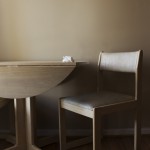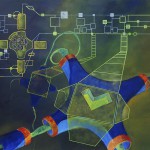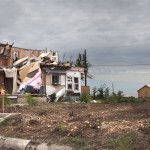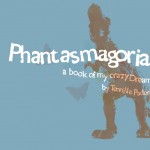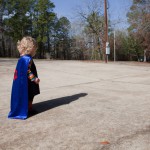April 19 – May 3, 2012
F. Elizabeth Bathea Gallery + Mary Wilfred Moffett Gallery
Point of Advent: MFA Thesis Exhibition
Thursday, April 19th
5 pm: lectures by Ashley Feagin and Dan Snow (VAC #103)
5.30 pm: exhibition reception
Point of Advent showcases six emerging artists, all Master of Fine Arts candidates at Louisiana Tech University, in a group exhibition as they begin their professional career. Each of the artist’s work reflects the three years they have spent perfecting and mastering their individual craft. Drawing from personal influences, this show proves to be a manifestation of each artist’s pursuit for excellence. Photographs, paintings, prints and book-making round out this collection that will be exhibited.
MFA Thesis Lecture Series
Thursday, April 19th, 5 pm: Ashley Feagin and Dan Snow
Wednesday, April 25th, 5 pm: Tennille Paden and Adrian Dean Gipson
Thursday, May 3rd, 5 pm: Caleb Clark and Rachul McCilintic
all lectures will take place in VAC room 103
Ashley Feagin bio
Ashley Feagin is fascinated by how people interact with one another. Our relationships, our pains, our habits, our fears all develop the collective story that inform and inspire Feagin’s work. After spending many years on the stage and briefly dabbling in sociology, she finally found her articulation in the camera.
Feagin’s work was recently selected to be published in Vermont Photography Workplace’s book Redefining the Self Portrait. Her work was also featured in the traveling group exhibition in 2011; Spinning Yarns. Feagin received her BA in Photography at McNeese State University in Lake Charles, Louisiana in 2009 and is pursing her MFA at Louisiana Tech University in Ruston.
Ashley Feagin statement
Bereavement research suggests that the attachment style that was fostered during childhood will be an indicator to the style of coping of loss during adulthood. Specifically with people who are emotionally significant to us, the ideals of those people will remain and become part of our inner conversation after the person is gone.
This series of photographs depicts the ups and downs of the seven years since my mother passed away from Non-Hodgkins Lymphoma. Three different photographic styles were used to depict denial, remembrance and mourning. The images are visual manifestation of the process in which I grieved / am grieving.
Adrian Dean Gipson bio
Adrian Dean Gipson was born in Natchitoches, Louisiana and raised in Monroe, Louisiana. He showed an interest and talent for art at an early age. Always encouraged by teachers, family and peers to pursue a career in art, he completed his Bachelors of Fine Arts degree with a concentration in communication design at the University of Louisiana at Monroe in May of 2007. Adrian is currently a Masters of Fine Arts candidate at Louisiana Tech University, with an expected graduation date of May 2012.
Adrian Dean Gipson statement
The main concept behind my artwork is centered on how I solve problems and process information that is new to me. In my work I use geometric and organic forms. The geometric shapes represent man made objects. The organic forms represent things from nature. These forms are merged together to symbolize the similarities between them. My Dad is a bricklayer and part time church pianist. I spent my summers learning masonry work, and my weekends learning musical instruments. These two facets of my upbringing gave me a great respect for handcraft skills and professional expertise. When I look at any man-made device, I usually ponder on its creator. The conversations my dad, my brothers and I would have, and the morals I learned through the nature of this kind of labor, played a vital role in the making of my personality. While working, my Dad often told these short stories that were like parables. He would relate something about bricklaying to a real life situation, and explain how to deal with that situation. The day-to-day perseverance, planned execution and troubleshooting I was taught in masonry work is the basic premise I apply to my artwork and any goal I set out to accomplish. My Dad taught me to approach everything in a planned and ordered way. When I attempt to solve a problem, or learn new information, I do so by looking for general patterns and rhythms, and then I create a working process based on those rhythms and patterns. My goal is to share these analogies with the viewer and have them experience it in their own way.
Dan Snow bio
Dan Snow has taken an unusual path towards photography. While spending eight years on the road as the lead vocalist and a guitarist for the heavy metal band, Rise To Ruin, Snow found he moving creatively away from music and towards photography. Snow was first introduced to photography while attending classes at Northwest Arkansas Community College where he received an Associate of Applied Science degree in graphic design in 2003. In 2009 he completed his Bachelor of Arts degree in photography from the Art Institute of Colorado in Denver, and was awarded the Certificate of Excellence. Snow is currently working towards his MFA in photography at the Louisiana Tech University School of Art, and is a working photographer in the southern United States. His current bodies of work focus on the aftermath of places of violent death.
Dan Snow statement
My interest in this work manifested itself in my childhood due to my father’s career as a police officer. I have a strong passion to understand the darker side of humanity, and how people like my father are there to protect us from these horrors. The death scenes I am photographing, I approach as both an investigator and artist. When visiting these places, I find some kind of beauty in them, but I ask myself; is there an emotional stain that has been left behind on the landscape? Is the location changed forever? How do the survivors cope? This body of work entitled Aftermath addresses these questions. These images portray the passage of time and the healing process; that for better or for worse, life goes on.
Over the past year, I have gone to different locations where some kind of tragedy has taken place. Fatal accidents, crimes, war, and natural catastrophes. The history of these locations may be viewed as dark or morbid, but they have a strange beauty about them. A beauty that exemplifies Victor Hugo’s definition of the sublime as a combination of the grotesque and the beautiful. When I am making my photographs, I try to keep this definition in mind.
Tennille Paden bio
Since early childhood Tennille Paden has had a deep curiosity of the dissimilar topics of nature, history, technology, human relationships and American Culture. As a graphic designer, her education and career experience has allowed her to explore these topics in detail which has resulted in an even more profound interest.
Born and raised in Montana, Paden’s early love of nature came easily. Avoiding mountain lions on the way to the school bus stop and with snow piling up to the roof, innovation was a way of life. The pioneering spirit, which is still very much alive in Montana, taught her to appreciate history and realize how much it ties in with daily living.
This education continued at York College in Nebraska. Corn and wind was quite a change but Paden earned her AA degree exploring the concepts of art and learning how to incorporate personal experiences and interests to make her work come alive. Next she learned about the technologies available in design at Harding University in Arkansas. After several years of hard study and appreciation of the striking fall foliage Paden graduated with a BFA in Graphic Design. Throughout her childhood and educational travels Paden had made many close connections with the diversity of people surrounding her. It was one of those personal ties that led Paden to her first design job. She was hired by Howard Books, a publishing firm, in Monroe, Louisiana where believe it or not, ‘gator hunting is legal for one month a year. After an eye opening five year career, Paden parted ways with Howard Books as the company relocated to Nashville.
Tennille Paden’s interest in education prompted her next step. In the fall of 2009, she enrolled in graduate school at Louisiana Tech to earn a MFA in Communication Design. She is currently in her third year and only looking back does she realize that her assorted interests all culminated to bring her where she is today. The beauty of nature, the harsh reality of history, the wonder of technology, the joy of personal interaction and connection, and the stunning differences of culture in America: these are the forces that have sparked Tennille’s work, education, travels, life. Her ultimate fulfillment is to realize that her life, work, and great loves are all one and the same.
Tennille Paden statement
My creations are the perfect pairing between the old and the new, familiar and cutting edge. To produce art I center on using a hybrid method of combining both longstanding and innovative technologies.
The colors and textures made on a hand printing press create an aesthetic sensibility that cannot be reproduced by a graphic generated solely on a computer. I communicate my ideas by starting with a photograph, manipulating it on the computer, transferring it to plate or stone, then printing out the image. The end product takes on a depth not otherwise possible. This technique works to bridge the gap between new technology and traditional processes such as stone lithography and copper plate printing. By balancing my hours spent on the computer with hours on the press I create my one of a kind hybrid art.
Rachul McClintic bio
Rachul McClintic gained knowledge and respect of artistic discipline and process while acquiring a Bachelor of Arts Degree from Ferrum College in Virginia. It was there she experimented with multimedia and observed collaborations among the contemporary art community. As a result, she has employed using various media as a vehicle to exhibiting her work. McClintic’s visual content continues to remain cognizant of historical and present gender debates and seeks to acknowledge a female perspective.
The years spent living in Virginia, San Antonio, Texas and Shreveport, Louisiana, as well as, in 2010 a study abroad in Paris, France have all influenced her cultural perspectives. McClintic’s publications include the 2011 Art Melt catalogue, featured in the Louisiana State Museum, Baton Rouge and a 2010 figure edition of Art Scene Today. She is perusing an MFA degree, with a concentration in studio.
Rachul McClintic statement
Compelling experiences from a female perspective, fuel the depiction of figures and symbols that interact within claustrophobic surreal like spaces. This work reflects states of relationships and female empowerment. Through photographic images, my work seeks to simultaneously allure and alienate, exposing elements of fixation, vacant seduction, and unsavory exploitation. Clandestine deeds and strange interactions between the figures speak of instability, fetish, and obsession.
Caleb Clark bio
Caleb Clark grew up in North Louisiana where he began studying the arts. He graduated from the University of Louisiana at Monroe with a Bachelor of Fine Arts degree in 2007. Clark then opened his own photography studio and gallery space in Ruston, Louisiana. In 2009 Clark entered the Master of Fine Arts program at Louisiana Tech University. Clark has exhibited in a variety of local and national venues, including the Betz Gallery in Houston, Texas, and the PhotoPlace Gallery in Middlebury, Vermont. Caleb was selected and published as a finalist in Photographers Forum, Best of Photography 2011 and Best of College Photography 2011. Clark’s current photography focuses on life changes, heritage and the dynamics of family.
Caleb Clark statement
The term family represents a group of people that live together and rely on one another. The challenge individuals in families face is adapting to changes. As children we are dependent on those around us to raise and shape us. Because we are individuals, not everyone in the family always agrees. The act of defiance is a natural process, which results from our instinctive strive for personal freedom, while reliant on our families for support, love, and affection.
The body of work I have been cultivating for the past three years represents my life and journey through graduate school as a student, father, lover, son, grandson, and more. The photographs are a visual projection of my inner thoughts, dwellings, and predicaments. This work has acted as a form of dialogue for me, providing a way to communicate and learn about myself. Dependence and Defiance is my personal diary. It tells stories about the relationships with my family. These images have the ability to put feelings back into my soul, they open a window to the past and provide a unique method of experiencing life.

